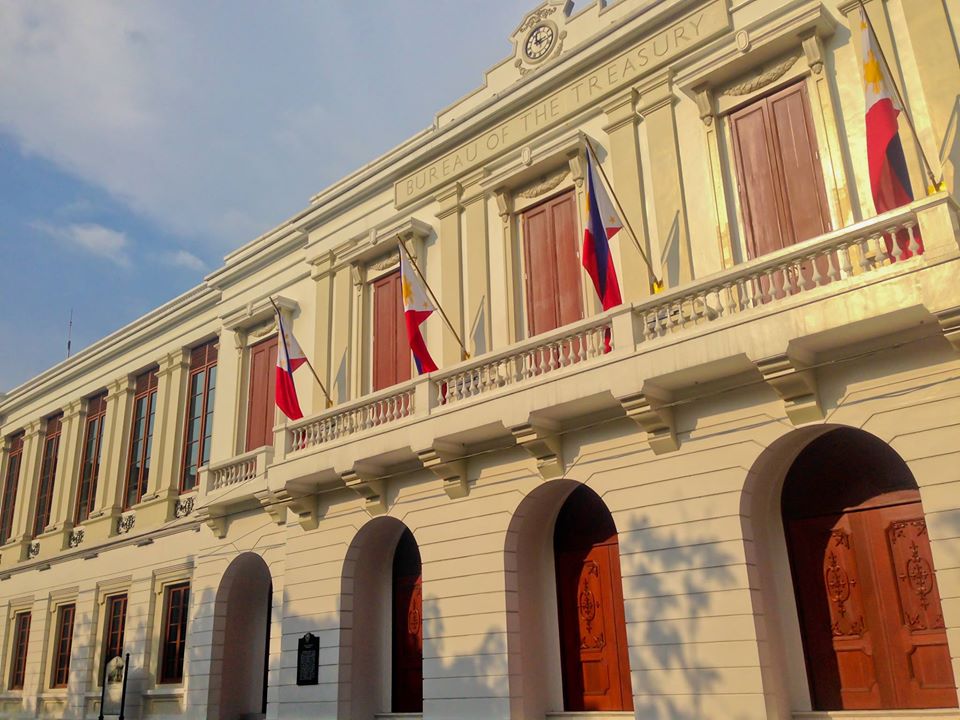Treasury: PH’s record-high debt remains “sustainable”

The Ayuntamiento de Manila which houses the Bureau of the Treasury (From the Facebook account of the bureau)
MANILA, Philippines—While Philippine debt as a share of the economy hit a 16-year high last year, taking into account all metrics would show that the national government’s ballooning obligations remained “sustainable,” a Bureau of the Treasury (BTr) official said on Wednesday (March 2).
Citing the BTr’s analysis and assessment of the Philippines’ debt until 2020, its risk management division chief Armin Paul Allado said that “there’s room for the country to absorb more debt given the optimistic outlook of economic recovery and growth.” The government targets 7 to 9 percent gross domestic product (GDP) growth this year, then 6 to 7 percent yearly in 2023 and 2024 to outgrow the huge debt pile wrought by massive borrowings to finance the prolonged fight against COVID-19.
In 2021, the national government’s outstanding debt as a share to GDP climbed to 60.5 percent — the highest since 2005. As the debt ratio exceeded the 60-percent threshold deemed manageable among emerging markets like the Philippines, President Rodrigo Duterte’s economic team will pitch a fiscal consolidation plan to the next President to repay debts.
The fiscal consolidation strategy to narrow the budget gap—while repaying obligations—would likely consist of new or higher taxes, spending cuts on non-priority sectors, as well as economic growth drivers to spur bigger revenues.
Speaking at an Asian Development Bank Institute (ADBI) conference, Allado said that in terms of debt quality, recent data reflected sustainability, pointing to the declining share of foreign obligations to the total outstanding amount, as well as the weighted average interest rate (WEIR) fetched by government borrowings.
For instance, the latest BTr data showed that the share of external debt to the end-2021 total further declined to 30.3 percent — the lowest in history — from 31.7 percent in 2020. The government borrows the bulk of its requirements locally through the issuance of treasury bills and bonds, in a bid to temper foreign exchange risks while taking advantage of flushing domestic liquidity.
Allado also noted that the WEIR for the Philippines’ borrowings further dipped to a low of 4.2 percent in 2020 from 5 percent in 2019, pre-pandemic. The Philippines’ investment-grade credit ratings allow it to borrow cheaper.
Also, Allado said that it was not only the headline debt-to-GDP ratio that determined sustainability — other indicators included the mix of domestic and foreign outstanding debt and financing; interest payments as a share to GDP, expenditures and revenues; as well as the annual GDP growth rate and budget deficit ratio.
After assigning corresponding weights to these debt metrics, the BTr’s calculations for what it called an annual public debt assessment index showed that in 2020, the 54.6-percent debt-to-GDP ratio — a jump from the record-low 39.6 percent in 2019 — remained below the sustainable debt ceiling of 59.97 percent for the Philippine economy.
“There is still room for debt level adjustments given the fiscal policy flexibility value of 5.37 percent” in 2020, Allado said. The graph presented by Allado nonetheless showed that the gap between actual debt ratio and debt ceiling, which reflected fiscal flexibility, was the narrowest in recent years as the government ramped up borrowings for COVID-19 response.
Until 2026, the BTr’s computations showed that the projected debt-to-GDP ratios would remain below the economy’s debt ceilings. For instance, last year’s debt ratio was below the estimated 88.3-percent ceiling, as the economy reverted to growth following the worst post-war recession in 2020.
For this year, the projected debt-to-GDP of 60.4 percent will be below the 74.4-percent ceiling. In 2023, the 60.5-percent debt ratio would be below the 78.4-percent ceiling; in 2024, the 59.7-percent debt-to-GDP will be below the 79-percent ceiling; in 2025, the 57.3-percent ratio will be below the 84-percent ceiling and in 2026, the 55.8-percent debt ratio will be below the 75.3-percent debt ceiling, the BTr’s estimates showed.
Allado said the BTr study’s findings showed that “the current and projected debt levels of the Philippines are still sustainable, leaving some policy flexibility to absorb debt in case of further adverse shocks.”
The government will borrow P2.2 trillion this year, of which three-fourths was to be raised from the domestic debt market.
This year’s borrowings will further raise the debt stock to P13.42 trillion by yearend, from P11.73 trillion in 2021.
